





Blocking is the main defensive action of players at the net to stop or alter an opponent's attack.
Blocking can also be offensive, aiming to completely stop the attack and keep the ball in the opponent's court.
A well-executed offensive block involves jumping and stretching to go over the net with the arms, sticking them out into the opponent's area. It therefore requires anticipating the direction of the ball in attack.
Blocking is part of the fundamentals of the phases of:
The block is classified according to the number of players involved. It can therefore be called a single, double or triple block.
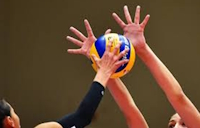 Single block Single block |
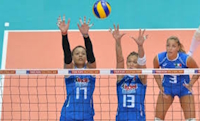 Double block Double block |
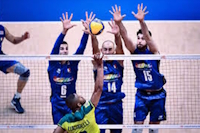 Muro triplo Muro triplo |
The block is a fundamental that does not present particular technical differentiation, but the needs of the game indicate functional situational adaptation strategies used by the players
The block is not always effective. Furthermore, it is sometimes circumvented with attack systems other than the spike (e.g. lob!).
However, a block that forces the attacker to use different strategies is still very useful.
The position of the block influences the positions in which the other defenders are placed, while the opposing servers spike.
Let's start with what we can define as the fundamental objectives of the block; namely:
These points will reach the greatest effectiveness, the better the execution technique. To be able to perform an effective blocking action, it is not essential to be very tall or jump a lot; that is, it is not the height of the wall that determines its success, but a set of other qualities that involve:
In particular, the evaluation of the most appropriate jump time will be related to the type of construction chosen by the opponent and will determine the precise times of the translocations and jumps!
will be related to the "space" that the wall will have to take.
The six players on a volleyball team have the duty, during the match, to rotate clockwise when their team is receiving and scores while the opponents are serving. Learning to rotate positions is, therefore, fundamental.
The roles in volleyball can be divided into two main fronts: attack and defence. The attack roles are played on the front line, that is, those players who play under the net.
During a volleyball match, there are six players but there is one, called the “libero”, who enters the court when the player occupying the central positions is on the second defence line.
The roles of the players on the court are five:
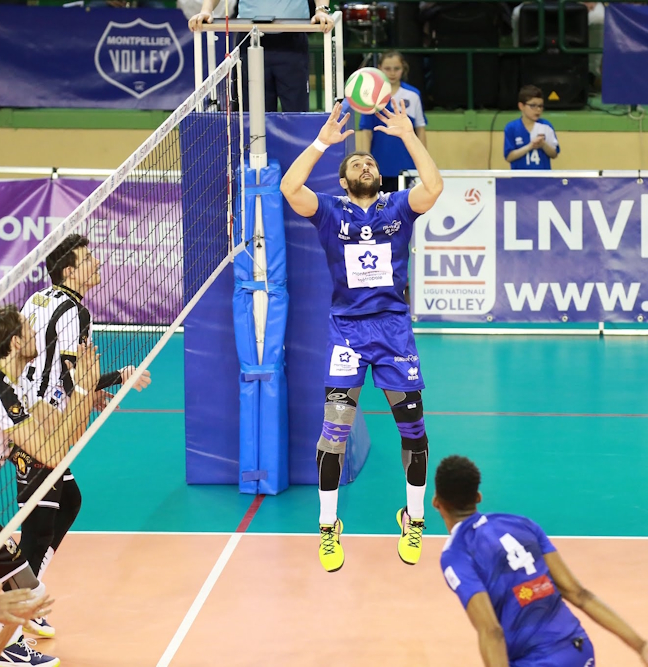 Setter Saitta in actionBoth on high and distant sets and on close and fast sets, the accuracy of the setting is fundamental.
Setter Saitta in actionBoth on high and distant sets and on close and fast sets, the accuracy of the setting is fundamental.
This is certainly the most typical characteristic of the setter, who must put his teammates in a position to spike positively. The regular performance of a spiker is, in fact, largely the result of constant accuracy in the settings he receives.
Furthermore, with equal accuracy of the set, what makes the difference between one setter and another is the choice of the type of setting, which can substantially influence the performance of the individual attackers and, consequently, of the entire team. In this case, we speak of tactical intelligence.
Every set requires great clarity to make the most of both the attacking potential of your hitters and the defensive weaknesses of your opponent.
Reactivity in movement is also essential: it is necessary because the setter is rarely already at the starting point of the court where he will perform the second touch and is often forced, instead, to cover several meters of running to get into the correct position on the ball. A setter with modest reaction times will frequently be late and therefore, finding himself out of balance, will hardly be able to set decent balls to his attackers.
A soft and natural touch of the ball is also very important. There are essentially two types of setters: those who have a natural touch of dribbling and those who have built it up over the years with training.
The substantial difference between these two categories is that the former has less difficulty in dealing with particularly stressful situations, while the latter, in positions of poor balance or conditions of high physical and psychological tension, tend to "dirty" the dribbling, which can also become imprecise and foul-prone (double fault).
The height of the players has become of determining importance (or if the player is short, he must have good elevation), especially to be able to block the opponent's attacks. Even the setters have felt the effects of this trend, taking into account, then, the fact that the setter, when he is on the front line, will have to block the attack of the side hitter of the opposing team.
The setter represents the cornerstone on which a team's offensive system is based, a crucial sector for performance.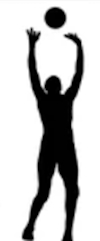
It is the connecting role between the reception (or defense) and the execution of the attack.
His initial position in the formation determines the so-called "phase" (numbered from 1 to 6, or P1, P2, etc.), from which the position of the other athletes and the possible game schemes to be implemented derive.
He must be a leader, not only on the field, but also off it.
He must possess a wealth of coordination skills that must be as broad as possible, based on which a high level of specific dribbling technique can be inserted.
He is certainly the player who cooperates most with the coach and shares his plans and strategies.
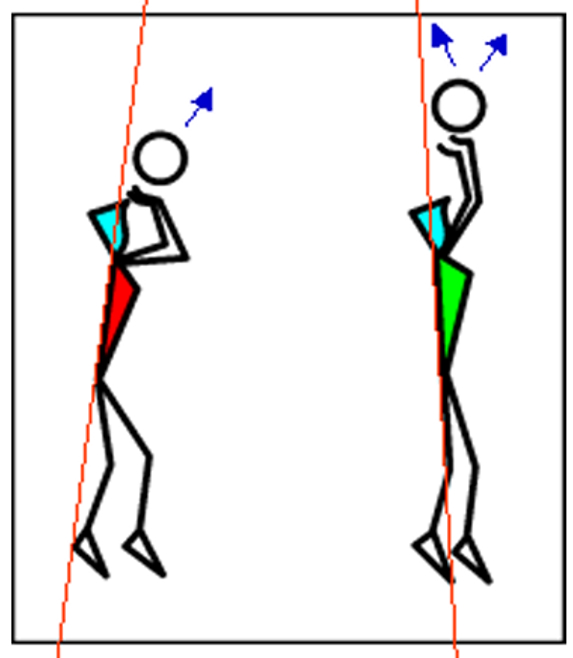
Even if, at a high level, there is an increasing tendency towards a simplification and standardization of tactical choices, the difficulty in the construction of the setter's game lies in the management of the various types of sets to be made.
A setter must combine the variety of trajectories, their precision, adapt their speed and their height to each of the attackers, and remain as unpredictable as possible for the opposing blockers.
The search for a neutral position under the ball for all types of sets makes it more difficult for the opposing blocker to read the tactical choices.
At the high level, the setter makes almost all of his sets in suspension. This depends on both a tactical need, because the attacking game becomes faster, and a technical need, since in the elevated dribbling it is easy to maintain the neutral position of the body.
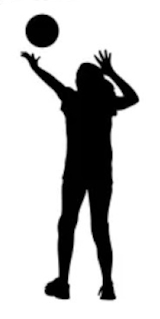
Serve in volleyball is the action that starts the game, in each set.
The player stands behind the baseline and hits the ball to reach the opponent's court in a single movement.
The goal is obviously to score a point, landing it within the valid perimeter. The serve point phase can be considered as the maximum expression of the individual player, because it is performed in full autonomy. In fact, in a set, in no other phase of the game does the player have complete control of the action as in the service.
It therefore requires a lot of skill in setting the direction and speed of the ball, so as to make it difficult for the opposing receiver to intercept it correctly in reception. Although in match situations the server does not communicate before the service, the coach can signal him to serve in a specific area. The service strategy often aims at the opponent's weaker receiver or the space (conflict zone) between two players. Therefore, serving with good ball control and direction is important.
The service is called "ace" when it scores the point, that is, if the ball falls directly into the opponent's court, or goes out after being touched by an opponent. This type of serve is therefore a winning serve, because it allows you to score a point automatically, without any reaction from the opponent.
In the youth categories, Under 12 and 13, the so-called "underhand serve" is used, in which the player hits the ball from below, not from above. Serves of this type are easier to learn: however, it is a more predictable serve than others, because it is parabolic, therefore much slower, it is considered very easy to receive and is rarely used in high-level competitions.
The overhead serve, on the other hand, is nowadays characterised by greater instability and unpredictability, which obviously makes it more insidious for opposing players in reception.
Until the first half of the 1990s, the service could only be performed from three meters to the right of the baseline (behind position 1, to be clear), but starting from 1995 it is allowed to serve along the entire 9-meter line (also behind position 6 and position 5), thus increasing the type of possible directions.
The following types of serve can be distinguished in volleyball:
The two favourite types of serve in volleyball are the jump float and the jump spin, but which one should you use?
If the disadvantage of the jump float is that it generates fewer aces than other serve techniques, since it is slower, performing a jump spin is always a risk, because – if not performed with enough power – it could be ineffective and easily predictable by the opposing team.
In addition, the jump spin serve requires a good amount of coordination and the ability to throw the ball which requires a lot of training. Each player and each team must evaluate how to move depending on the situation on the court and the technique they want to implement.
When you have to decide what type of serve to make, you have to evaluate whether to use a tactical serve or a strong one, depending on the objective you want to achieve:
An effective server must therefore develop both a powerful serve and the ability to serve in a specific area..